Bits of Baseball Lore - X
As the 1943 New York Yankees prepared for the World Series, they decided they needed some help to defeat the St. Louis Cardinals. Were they thinking about a late callup from the minors? Perhaps an injured player getting healthy? No, they needed a special song.
A song? How ridiculous, you say! Wait! Hear me out. Their concern wasn't just superstition. It had a basis in fact.
- As the 1941 Yankees stormed down the stretch to the first of three straight AL pennants, the boys made a marching song out of "The Beer Barrel Polka." For weeks, the supposedly staid Yanks would belt out "Roll out the barrel" without the slighest provocation. Result: Joe McCarthy's club rolled out the Brooklyn Dodgers in five games in the Fall Classic.
- The next season, the song writers neglected to provide the musical-minded Yankees with a lyrical lift. Result: They fell to the Cardinals in five games in the World Series.
- While no one blamed the lack of harmonious signing for the defeat at the time, the '43 club decided to take no chances. Led by their Poet Laureate, 2B Joe Gordon, they adopted a ditty called "Pistol Packin' Mamma" as their theme song. Every time they chimed in on a chorus of "lay that pistol down," people for blocks around wanted to pick up their guns and start firing at them. When the Yankees clinched the pennant that they ultimately won by a whopping 13.5 games, McCarthy threw a party in the big banquet room of the Ruppert Brewery (Jake Ruppert being the late owner of the franchise). The Yankee songbirds clustered around the piano and belted out their Mamma song again and again until the brewery management finally turned out the lights and shooed them home. Result: The Yankees shot down the Redbirds in five games, a complete turnaround from '42 and reversion to '41.
Reference: "'Pistol-Packing Mama' May Be Bad News for Cardinals,"
Judson Bailey, Associated Press, 9/29/43 |
|
From 1969-1980, the Cleveland Indians finished no higher than fifth in the six-team AL East. But after winning four of their last five games on a road trip, the 1981 edition of the Tribe returned home for a game with the Toronto Blue Jays on Friday, May 15, leading the division by one game.
25-year-old righty Len Barker, the scheduled starter for the home team, almost didn't make it to the park on time.
- He had to pick up his brother at the airport. However, the plane arrived late, only an hour before game time.
- So Len had to rush to the ballpark, get his arm rubbed down, put on his uniform, and hurry onto the field to warm up.
Despite Cleveland's strong start, only 7,290 fans showed up in 49° weather in cavernous Lakefront Stadium. They were rewarded for their loyalty with a perfect game.
- Barker threw mostly fast balls early. In the second, 2B Duane Kuiper made a diving stop and threw out Willie Upshaw.
- Two unearned runs in the bottom of the first gave Barker a quick lead.
- In the fifth, 3B Toby Harrah learned into the stands to catch a foul ball. Otherwise, there weren't many tough plays. There was a line drive off of a changeup, right at the 2B, recalls Len. After that, I got rid of the changeup.
- Ron Hassey, who would go on to catch another perfecto for Dennis Martinez, started calling mostly curve balls when he realized Barker had a good one going.
- I'm not superstitious, but my teammates were. When the seventh inning rolled around, the manager, coaches and the players were down in one end of the dugout, and I was on the other, all by myself - though Harrah and Rick Manning told me in the seventh inning that they were behind me and they knew I could get it.
- I started thinking about the perfect game in the seventh. I didn't really think I could get it until the ninth. When I went out there, I was pretty confident I could throw the perfect game.
- Len struck out 11 of the final 17 batters, including Al Woods pinch-hitting for 3B Danny Ainge, on three pitches for the 26th out. Another PH, Ernie Whitt, flied out to end the 3-0 victory in 2:09.
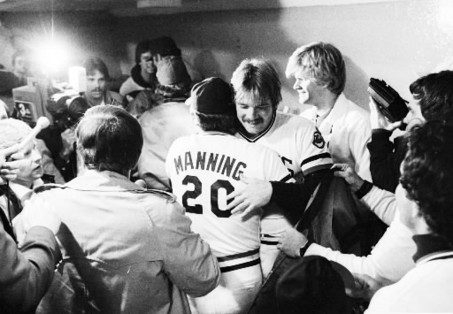 Len Barker after his perfect game
Len Barker after his perfect game
At that point, Barker's gem was only the 10th perfect game in ML history.
- There are a lot of stories people tell me about where they were, what they were doing.
- One story stands out above the others.
I had a lady come up to me and tell me she was in labor and she told the doctor she's not going to have the baby until the game was over, and she waited.
Alas, after starting 16-8, the Indians fell to last place (sixth) on June 10 and remained there the rest of the season.
- Coming off a 19-12 season in 1980, Barker won only five more games to finish 8-7.
- He won 15 in 1982 for the Tribe before being dealt to Atlanta during the '83 campaign.
Reference: I Remember ..., Len Barker, Sporting News, 05/09/2011
Top of Page |
|

Wilson Valdez
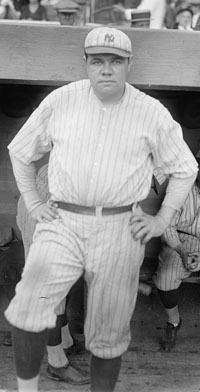
Babe Ruth 1921
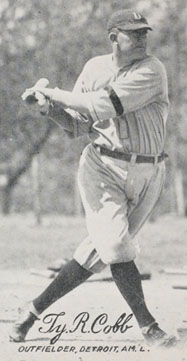
|
It Took 90 Years to Duplicate It
On May 25, 2011, Wilson Valdez of the Phillies became the first player in 90 years to start a game playing the field and end up the winning pitcher. And the player who accomplished that feat in 1921? None other than Babe Ruth.
- Valdez, who hadn't pitched since high school, played the first 18 innings against the Reds at 2B.
- Having run out of pitchers, pitching coach Rich Dubee asked Valdez if he could pitch. "I'm going to say, 'Yes,'" said Wilson afterwards.
- He hit the first batter, Scott Rolen, then retired Joey Votto and Jay Bruce on fly balls and opposing moundsman Carlos Fischer on a pop-up. His fastball was clocked at 88-89 mph.
- "I was trying to throw strikes," Valdez explained. "If I give up a HR, what are they going to say?"
Babe Ruth, who retired from P in 1919 to play every day for the Red Sox, won two games in 1921, his second season with New York. He started against the Tigers on June 13 before 12,000 fans at the Polo Grounds, the Yankees home park that they shared with the Giants. Why he started is a story in itself.
- Babe yearned to settle a score with Ty Cobb, Detroit's player-manager.
- The day before, Cobb had humiliated Ruth in front of 34,000 fans, "pantomiming like a gorilla and pushing his nose up when the Babe ran past him."
- At one point during the game, Cobb and Ruth squared off to fight, but umpire Bill Dinneen broke it up. When Ruth struck out in the fourth, Cobb whistled and roared.
- Immediately after the game, Babe rushed to manager Miller Huggins. "Let me pitch against Detroit. I want to show Cobb up."
- He pitched 5 innings, giving up 4 runs (3 earned), 5 hits, and 7 BBs. In his last inning on the mound, Babe had the pleasure of striking out his nemesis.
- Leading 10-4, he moved to CF for the rest of the game. The Yankees held on, 13-8.
- Batting in his usual third spot, Ruth hit 2 HRs, one as a P and one as CF. As the Babe romped across second during one of his HR trots, he sent a
shrill and mocking laugh out to the
desolate Cobb in CF.
On October 1, the second-to-last day of the season, Ruth reversed what he did June 13 by starting in the field before becoming the winning pitcher.
- The Yankees led the Cleveland Indians by 2 games with three home games left with the Philadelphia Athletics.
- In the first game of the doubleheader, the Yankees prevailed 5-3 to clinch the franchise's first pennant.
- Babe started in LF in the nightcap, then moved to 1B. Batting in his usual third spot in the order, he went 1-for-4 to end the day at .376.
- Leading 6-0 in the top of the eighth, manager Miller Huggins put Babe on the mound. The A's smacked the rusty southpaw around to tie the game before he finally retired the side.
- Ruth settled down and pitched three scoreless innings until the Yanks plated a run in the bottom of the 11th. Instead of starter Waite Hoyt notching his 20th victory, Babe got his second.
|
A Boy's First World Series Game
Bob Broeg was a St. Louis sportswriter who was elected to the Baseball Hall of Fame in 1980. In his autobiography, he recalls his first World Series game.
- The Cardinals hosted the Philadelphia Athletics in Game 5 of the 1930 World Series. The teams were tied at two games apiece.
- Young Bob persuaded his parents to give him a dollar for a bleacher seat and permission "to play hooky."
- "I left home at 4 a.m. carrying a brown sandwich bag and made a couple of streetcar changes in the half-hour's trip to the ball park [Sportsman's Park]. Years later, Mom would wonder how she could allow her 12-year-old son to go out alone in the middle of the night."
- Broeg stood in the block-long line to wait for the opening of the RF bleacher gates.
- "A band began to play early on the outfield grass. And then the Cardinals appeared in brand-new uniforms."
The St. Louis starter was 37-year-old righty Burleigh Grimes, the last legal spitballer since he had thrown it prior to the 1920 ban. Broeg recalled Burleigh's style.
- "Grimes always raised his arms in a stretch position and brought the glove and bare hand to his mouth, concealing the ball."
- "More often than not, he flicked spit on the ball, creating a scientific situation by which the pitch seemed to fall abruptly off the table ... The dipping fast ball nosedived into a sinker."
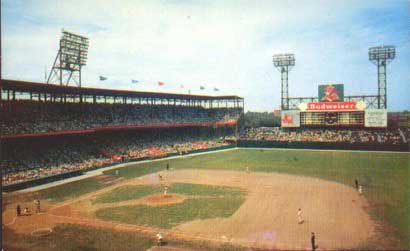 Sportsman's Park St. Louis
Sportsman's Park St. Louis |
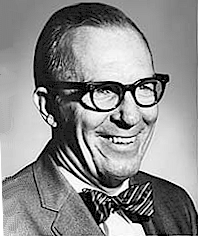
Bob Broeg
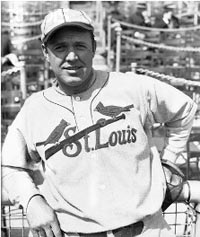
Burleigh Grimes
|
The game was scoreless into the top of the ninth, George Earnshaw matching goose eggs with Grimes for seven innings before Lefty Grove pitched the eighth.
- Grimes walked C Mickey Cochrane to start the ninth. Then LF Al Simmons flew out. That brought 1B Jimmy Foxx to the plate. (Note the three straight Hall of Famers in the A's lineup.)
- Broeg: "Square-jawed, cap pulled tightly on his head like a jockey, Grimes occasionally faked the spitter and threw a curveball. That's exactly what Foxx was looking for. As Double-X would explain later, Burleigh had struck him out once with that slow curve, and Foxxie was guessing he'd see it again. I'll never forget watching the ball arch majestically off the slugger's bat far up into the bleachers in left-center."
- Grove set down the Cardinals to gain the 2-0 victory. Two days later, Connie Mack's Athletics wrapped up the series back home.
Broeg reports a post-game incident that took on significance many years later.
After the game, a western Missouri judge headed back for Kansas City with a carload of friends and stopped for gasoline on the outskirts of St. Louis. The filling station operator didn't have a radio and wondered about the score. "Jimmy Foxx 2, Cardinals 0," piped the judge, Harry S. Truman.
Bob returned to school the next day.
- His seventh-grade teacher asked him where he'd been the day before.
- "The World Series, Miss Prindable," he replied honestly.
- She smiled. "Good thing you told the truth, Robert," then explained that she lived near Sportsman's Park and saw him standing in the bleacher line while walking to catch the streetcar to school.
|
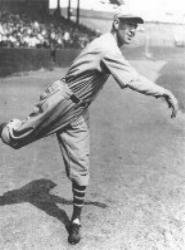
George Earnshaw
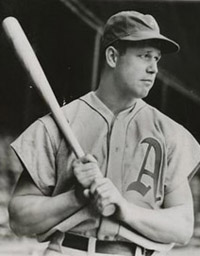
Jimmy Foxx
|
Hall of Famer Willie McCovey grew up in Mobile AL, home of other excellent players like Hank Aaron and his brother Tommy, Satchell Paige, Billy Williams, Amos Otis, the Bolling brothers (Frank and Jack), Juan Pierre, Jake Peavy, and Steve Sparks.
The same Hall of Fame scout who signed Willie Mays from Birmingham, Alex Pompez, arranged for 17-year-old Willie to go to Melbourne FL for a tryout at the New York Giants training camp in 1955.
I didn't think I impressed them that much. We lived in an old army barracks. Alex Pompez would, on a daily basis, walk down the hall at the end of the barracks to let us know how we were doing. He had that look on his face when he approached me that I didn't make it. Pompez asked me, "Why don't you hit?" I said, "Well, I guess I'm a little nervous." He said they liked me anyway, and they were going to take a chance and sign me. It's funny because the day after he told me that, I went out and hit two home runs and started producing. But I didn't think I showed much before they told me they were going to sign me.
- Willie started in Class D and worked his way up: B in '56, AA in '57, then AAA in '58.
In 1959, with Mac tearing up the Pacific Coast League, the Giants, now located in San Francisco, called him up for their July 30 game against the Phillies at Seals Stadium (their temporary home until Candlestick Park was built).
- Willie recalls the call-up vividly.
We had played a doubleheader that night in Phoenix, and I had played both ends. ... The general manager of the Phoenix Giants came into the clubhouse and said, "You're going to the big club. They want you up there tomorrow." I was all excited, but it was midnight and the Giants were playing a day game the next day. So I kind of panicked in a way, wondering how I was going to collect all my things to take with me. It never occurred that I could get some of my friends to send them to me, so I was thinking that I had to gather all my things. I had loaned records and other things to friends all over town, and I tried to go collect them all.
Anyway, I made it up to San Francisco on time. I didn't get any sleep that night, naturally, because I was all excited about the big league club. I got there just in time to go straight to the ballpark and didn't even take batting practice. Practice was over when I got there. I walked into the clubhouse. I had been in Spring Training with the team, so that took a little of the edge off, because I knew all the guys ...
Bill Rigney was the manager, and he asked me how I felt, and I said I felt great. He said, "You're in the lineup today, and you're hitting third, and you know what that means." I said, "What?" He said, "That's Willie Mays' spot in the line-up. I'm moving him up to second and yhou're hitting third today." So that put a little more pressure on me.
- To add to the pressure, Willie had to face Phils ace Robin Roberts, a future Hall of Famer.
|
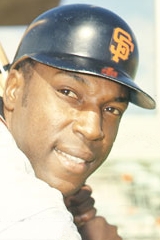
Willie McCovey, Giants

Alex Pompez
|
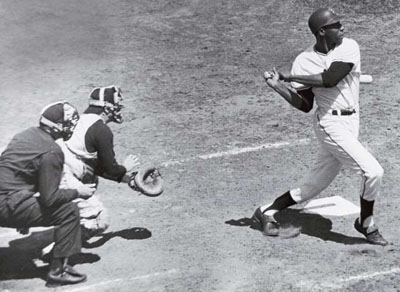 Willie McCovey in his debut game
Willie McCovey in his debut game
McCovey excited Giants fans immediately.
- All he did in his debut was go 4-for-4, with 2 triples, 3 runs, and 2 RBI as the Giants won 7-2.
- Willie played 51 games for SF that season, compiling these rookie numbers.
.354 BA, 13 HR, 38 RBI, .656 SP
Willie played 14 more years for the Giants before moving to the Padres, the A's, and back to SF for 4 more years.
- He finished with 521 HRs in 22 seasons.
- Willie Mac was inducted into the Hall of Fame in 1986
Reference: "Willie Mac Marches On," Brad Horn, National Baseball Hall of Fame 2011 Yearbook
Top of Page |
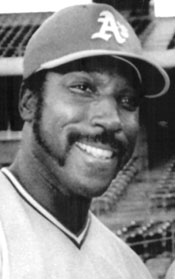
Willie McCovey, A's |
|
Founded in 1961, the Los Angeles Angels became the California Angels in 1965 and finally had their own ballpark in Orange County in 1966.
- As the team failed to contend for a pennant year-after-year, rumor spread that Anaheim Stadium was built on a Native American burial ground.
- Therefore, the team was cursed just as the Red Sox had to endure The Curse of the Bambino and the Cubs, The Curse of the Billy Goat.
Fast forward to 1977. The Angels are mired in a slump as they prepare to meet the Yankees August 3 in the finale of a three-game home series.
- The club has lost six of their last eight and 17 of the last 26.
- Dave Garcia replaced Norm Sherry as the manager on July 11 without much improvement (11-12).
- Off-season acquisitions Joe Rudi and Bobby Grich are on the DL, the latter with a herniated disk in his back incurred while lifting an AC unit at his apartment in February. After trying to play, Grich had season-ending surgery in July.
Los Angeles Herald-Examiner writer Dick Miller has an idea for ending the team's bad luck.
- He contacts Louise Huebner, dubbed "the official witch of Los Angeles County."
- Mrs. Huebner, who appeared on The Tonight Show Starring Johnny Carson in 1970, visits the Angels and gives owner Gene Autry, GM Harry Dalton, and the players medals to rub each night at 9 PM when the moon is fullest.
- She promises they will draw on "a reservoir of psychic and spiritual energy" and see "an improvement in sexual activity."
Maybe it's the new energy or maybe it isn't, but the Angels start a winning streak, beating the Yankees 5-3 as Nolan Ryan garners his 15th victory.
- The Angels sweep three from the East-leading Orioles before embarking on a road trip.
- They win both games of a doubleheader at Kansas City August 8 to run their winning streak to six in a row, their longest of the season.
- Their record reaches the .500 mark, 54-54.
However, back in LALA Land, Huebner has decided the team is composed of devils, not angels.
- Some players embraced her witchcraft as fun. However, others, like Bobby Bonds, condemned it as black magic and evil.
- Growing tired of the players' comments, she withdraws her support of the team.
- Louise's explanation after the Angels begin losing again:
Some of the players were very insulting. I wasn't too thrilled being involved with them. I felt I shouldn't have used the energy of the Magic Circle [4,000 witches nationwide], because the Angels were not sincere and honest. They didn't participate or give anything back. I'm not Mary Poppins. I don't have to help anybody. So I just pulled out. I put the Curse back on.
Whether it's the curse or not, the Angels lose in Boston August 10.
- That starts a backward slide that produces only seven wins in 22 games.
- The team finishes the season 74-88 in fifth place in the AL West, 28 games behind the Royals.
In the 1990s, the Angels' media relations director researched the claim that Anaheim Stadium rested on an Indian burial ground but found no evidence that it did.
|
References: "Of Witches, Hexes, and Plain Bad Luck: The Reputed Curse of the Los Angeles Angels of Anaheim,"
Stephen Roney, The National Pastime 2011
Haunted Baseball: Ghosts, Curses, Legends, and Eerie Events, Mickey Bradley and Dan Gordon (2007) |
Rapid Robert and The Babe
In his autobiography, Bob Feller recounted "one of my favorite baseball memories."
- In 1928, Babe Ruth and Lou Gehrig came to Des Moines IA in October with their barnstorming teams - the Bustin' Babes and the Larrupin' Lous. Nine-year-old Robert lived in Van Meter IA, 25 miles away.
- The exhibition game included special rules, one of which was that Babe and Lou batted every inning for their teams.
The thought of a nine-year-old farm boy named Bob Feller getting to see Babe Ruth and Lou Gehrig - and nine times at bat for each of them, plus a pre-game batting show and Babe pitching one inning - was making me jump out of my skin.
- In addition, a local hospital was selling baseballs autographed by Ruth and Gehrig for $5.
Bob concocted a plan for raising the money to buy one of those balls.
- Because of an overpopulation of gophers, the county government paid 10 cents for each pair of front claws of any dead gopher.
- Bob's method was ingeniously simple. He gave a gunny sack to his neighbor pal and told him to hold it over a gopher hole in the Fellers' field.
Then I ran a hose from the gopher's mound to the exhaust of Dad's 1922 Dodge truck, turned the engine on and pulled the choke knob out all the way. I was careful not to use up all the gas. After all, it cost Dad six cents a gallon.
- The boys smoked out 50 gophers in two hours. Mr. Feller drove his son to the county courthouse where he presented his claw sets and collected $5.
- Later in the week, the Fellers drove to the Des Moines ballpark where Bob bought one of the autographed baseballs. "My first gopher ball," he called it. He still had the ball in 1991 when he wrote his autobiography.
"It would have been crazy even to dream that I would meet up with both Ruth and Gehrig later, but that's what happened."
- Bob pitched against Lou several times in the American League before Lou's retirement in 1939.
- Also, Feller "was able to be of some help to Babe on his last day in his Yankees uniform."
The occasion was Babe Ruth Day at Yankee Stadium on June 13, 1948. The visiting team was the Cleveland Indians, and Feller was the starting pitcher.
- Babe was dying of cancer, and everyone in the crowd of 49,641 knew it.
- As Feller warmed up in the bullpen, Ruth walked through the Cleveland dugout on the 3B side of Yankee Stadium on his way to home plate for the pre-game ceremonies.
- Seeing Babe unsteady on his feet, Indians 1B Eddie Robinson grabbed a bat from the rack and handed it to Ruth so he would have something to lean on.
- "It feels good," Babe said of the bat, which happened to be Feller's Babe Ruth model.
- Within minutes, the picture below, one of the most famous in baseball - and even American - history, was taken.
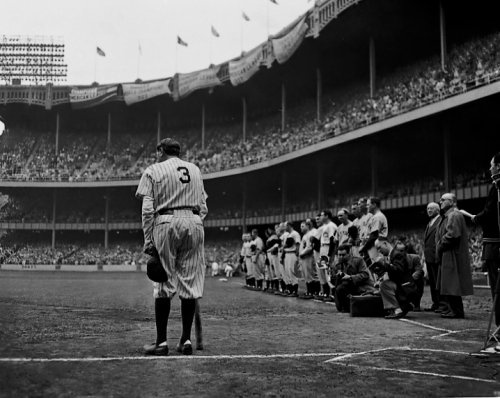 Babe Ruth on the day the Yankees retired his number in 1948
Babe Ruth on the day the Yankees retired his number in 1948
The first time Feller was due up, he couldn't find his bat. He sent the bat boy into the clubhouse to get another one.
- It wasn't until 34 years later, in 1982, that I found out what happened to my bat. ... After the ceremonies, Ruth brought my bat back to the dugout. Then Eddie did something understandable: He kept the bat. He couldn't bear giving up something so precious. I've never blamed him. I would have done the same thing.
- The only time since 1948 that I've seen my Babe Ruth model bat is in Babe Ruth's hands in that picture.
Reference: Now Pitching Bob Feller, Bob Feller with Bill Gilbert (1991)
|

Babe Ruth and Lou Gehrig

Bob Feller

Eddie Robinson
|

Jimmy Powers in later life
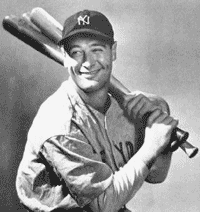
Lou Gehrig
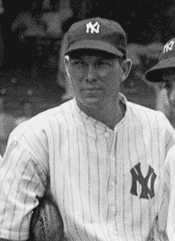
Bill Dickey
Top of Page
|
Gehrig's Disease Infects Yankees?
Entering the 1940 season, the Yankees had won four World Series in a row.
- Yet on August 8, Joe McCarthy's club dropped to 50-51.
- They occupied fifth place, 11.5 games behind the Detroit Tigers.
Since it had been ten years since the Yankees finished lower than second, reporters didn't know how to react to the Bronx Bombers' unexpected drop.
- One writer, Jimmy Powers of the New York Daily News, threw out a theory under the headline, "Has 'Polio' Hit the Yankees?"
Has the mysterious 'polio' germ which felled Lou Gehrig also struck his former teammates, turning a once great team into a floundering non-contender? According to overwhelming opinion of the medical profession, poliomyelitis, similar to infantile paralysis, is communicable. The Yanks were exposed to it at its most acute stage. They played ball with the afflicted Gehrig, dressed and undressed in the locker room with him, traveled, played cards and ate with him. Isn't it possible some of them also became infected?
- Gehrig had been diagnosed with his disease in 1939 and had retired during the season. The affliction had not yet been named "Lou Gehrig's Disease," and the term amyotrophic lateral sclerosis (ALS) was not yet in widespread use in this country.
- Still, Powers showed abysmal ignorance in referring to Gehrig's disease as polio.
Powers' theory produced immediate negative reaction.
- The Yankees denounced the column and demanded a retraction, which Powers refused to give.
- At Gehrig's request, Milton Eisenberg, a Brooklyn attorney, filed suit September 9 for $1 million against Powers and the newspaper charging that Lou's reputation and credit had been hurt, and that the article had caused him considerable mental anguish. The 1B had become "a pariah whom many people shun."
- Additionally, ten current Yankee players, including C Bill Dickey, also brought suits against the Daily News asking for $2.5 million.
Finally, on September 26, the newspaper issued a public apology.
- The three and a half column story appeared under the headline "OUR APOLOGIES TO LOU GEHRIG AND THE YANKEES."
- Powers admitted he had no business getting "snarled up in medical controversy," stating "Gehrig has no communicable disease and was not suffering from the mysterious polio germ that supposedly played havoc with the Yankee ball club." Lou was his personal hero, added Powers. "Hurting his feelings was far from my mind."
- Gehrig's suit was subsequently dropped as were the suits by the other players.
Meanwhile, the Yankees dispelled Powers' theory on the diamond.
- The club went 32-14 from the date of the original article.
- They finished the season in third place, only 2 games behind the pennant-winning Tigers and one behind the Indians.
- New York went on to win the pennant in 1941, 1942, and 1943.
Powers continued writing and served as sports editor for the Daily News until his retirement in 1959. The Gehrig controversy would by no means be the last of his tenure.
Lou Gehrig died from ALS on June 2, 1941.
|
41-year-old Stan Musial started in LF in the second game of a doubleheader on Saturday, July 7, 1962.
- Stan had a pinch single in the first game against the New York Mets at the Polo Grounds, the visiting park where he hit the most HRs in his career.
- With Game Two tied at 2 in the top of the eighth, Stan rapped a HR into the RF stands to give the Cards a split for the day.
- With 2-for-4 in the nightcap, Stan raised his average to .325.
The final game of the four-game series preceding the All-Star break brought more fireworks from Stan.
- First inning: Musial, batting cleanup, followed Bill White's HR with one of his own to give St. Louis a 2-0 lead off RHP Jay Hooks.
- Third: Stan drew a walk from Hooks.
- Fourth: Musial blasted another homer off Hooks into the RF stands, scoring White from 2B and making the score 9-0.
- Seventh: As the first batter facing LHP Billy Hunter, Stan crashed his third round-tripper of the day to make the score 10-0.
- Eighth: Perhaps overanxious to get his fourth, Stan struck out but reached first on the wild pitch. Skipper Johnny Keane sent in Bobby Smith to run for Musial, who exited to the cheers of the crowd of 12,460.
- As it turned out, Stan would have gotten another crack at tying the all-time record of four HRs in a game because the Cardinals continued to clobber the woeful Mets' pitching to the tune of 15 runs. Smith made the last out in the top of the ninth.
- Bob Gibson lost his shutout in the last of the ninth to make the final 15-1.
- The 3-for-4 afternoon lifted Musial's average to .333 as he left for Washington and the All-Star game at the new D. C. Stadium (later renamed Robert F. Kennedy Stadium).
Since it was widely anticipated that Musial would retire at the end of the '62 season, the Mets scheduled Stan Musial Night when the Cards returned to the Polo Grounds in August.
- But Stan returned for the '63 season after finishing '62 with a .330 average in 135 games.
- Musial slumped to .255 with 12 HR and 58 RBI in what was his finale in 1963.
|
|
Billy Herman, Joe Tepsic, and the '46 Dodgers
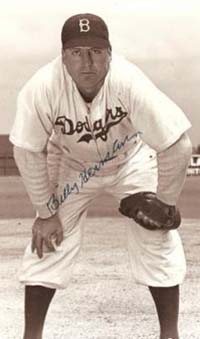
Billy Herman
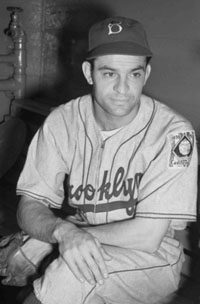
Cookie Lavagetto

Joe Tepsic
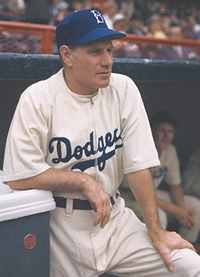
Leo Durocher
|
The 1946 NL pennant race between the St. Louis Cardinals and the Brooklyn Dodgers was the tightest in major league history to that point because it ended in the first-ever tie. The Cardinals won the best-of-three playoff in two games.
In any season with such a disappointing finish, second-guessing abounds. Many have pointed fingers at Dodger GM Branch Rickey for two transactions he made that season.
June 15
- Rickey traded 3B Billy Herman (a future Hall of Famer) to the Boston Braves for 33-year-old C Stew Hofferth who would never play another game in the majors.
- The trade ostensibly fit Rickey's philosophy of trading a player "a year too early rather than a year too late." Herman would celebrate his 37th birthday on July 10.
- But Billy's stats didn't show a player over the hill. He was hitting .288 with Brooklyn and then raised that to .306 in 75 games with Boston.
- 33-year-old Cookie Lavagetto took Herman's place at the hot corner for the Dodgers but finished the season with a .236 average.
- So what was the real reason Rickey traded Herman? One story claims that the GM got rid of Billy after he refused to pay for damages to his hotel room after a wild party during a road trip. Herman later explained why he refused to reimburse the Dodgers.
I got the blame for it, but I didn't do it. I wasn't even in my room that night. It was my room all right, but I had traded rooms with another player. I won't tell you his name. But I switched rooms with him so he and his buddy, my roommate, could party. I just went up to the other room and slept, and I didn't know anything about it until I checked out the next morning. ... It might well have been the reason Rickey traded me, because Rickey was an idiot about those kinds of things anyway. It was also true that I was making too much money [$20,000] for Rickey to pay. He was a tight, cheap, old bastard. It was all right that he traded me. I didn't care. I got more money with Boston. I just wasn't going to complain and get someone else in trouble.
July 8
- Rickey signed Joe Tepsic, "all-around athletic star at Penn State." Joe played football as well as baseball for the Nittany Lions after recovering from wounds suffered on Guadalcanal. An October 12, 1945 story in the Washington Post on the upcoming Penn State-Navy football game said:
A Jap bayonet ripped Tepsic's arm and shoulder two years ago, but a year of hospitalization, followed by a year of rest and recreation, has enabled the former Marine to stage a brilliant sports comeback.
Last spring, less than a month after his admission to college under the GI Bill of Rights, Tepsic reported for baseball. He showed good form and his .500 batting average attracted the attention of a dozen major league scouts.
- Tepsic did so well on the gridiron in 1945 that the Pittsburgh Steelers made him their fourth round draft pick. He played baseball again in the spring of '46 before signing with the Dodgers.
- The outfielder received $17,000 bonus, a huge amount for that era. Branch explained, "Tepsic has all the physical capabilities that a boy needs to make good in the majors. Unless he shows signs of needing minor-league schooling, he will remain with the Dodgers all season."
- Rickey was disingenuous in that announcement since Tepsic had insisted on a clause in his contract that forbade the Dodgers from sending him to the minors without his consent.
- Manager Leo Durocher didn't seem too pleased to have Tepsic on his roster. Joe appeared in only 15 games the remainder of the season, mostly as a pinch runner. Tepsic batted only five times with no hits.
- Needing every man on the 25-man roster in their battle with the Cards, Tepsic's teammates, with Dixie Walker as their spokesman, tried to persuade the rookie to agree to a demotion to the minors. But Joe was adamant, saying he "would play baseball in the majors or not at all."
- The Dodgers met on September 17 to decide who would get shares of their World Series loot. (In addition to the league champion, the next three teams in the final standings received shares based on their finish. And it was clear Brooklyn would easily make the "first division.") Figuring Tepsic had gotten his bonus when he signed, the players first voted to give him nothing, but Durocher, knowing Joe would appeal to Commissioner Happy Chandler if left out entirely, talked them into a 1/8 share.
- Tepsic's situation was one of the factors that persuaded the owners to pass a rule for the '47 season stipulating that any player given a signing bonus of $6,000 or more could not be sent to the minors without passing through waivers first. The intent of the rule was to discourage teams from paying big bonuses to untried prospects.
- Tepsic went to the minors in '47 and played with various clubs through 1951 without ever playing in another big league game.
Reference: Rob Neyer's Big Book of Baseball Legends (2008)
Top of Page |
|
CONTENTS
Special Song
Hold the Baby!
It Took 90 Years to Duplicate It
A Boy's First World Series Game
No Sleep? No Problem
It Was Magic!
Rapid Robert and the Babe
Gehrig's Disease Infects Yankees?
Stan's Still the Man
Billy Herman, Joe Tepsic, and the '46 Dodgers
Baseball Lore –
I
Baseball Lore – II
Baseball
Lore – III
Baseball
Lore – IV
Baseball
Lore – V
Baseball
Lore – VI
Baseball
Lore – VII
Baseball
Lore – VIII
Baseball
Lore – IX
Baseball
Lore – XI
Baseball
Magazine
Golden Rankings Home
Top of Page
|